The OnePlus 3 Review
by Brandon Chester on June 20, 2016 8:00 AM EST- Posted in
- Smartphones
- OnePlus
- OnePlus 3
System Performance
2015 was not a great year for Android devices. Snapdragon 810’s problems with throttling severely crippled the performance of high end smartphones. In the case of the OnePlus 2, OnePlus went even farther by putting in code that would detect when Google Chrome was in use and completely shut off the A57 cluster on the SoC. This resulted in web browsing performance that was essentially no better than what you’d find on a $100 phone shipping with Snapdragon 410, which simply wasn’t acceptable given the fact that the OnePlus 2 was priced at around $400.
Like most of this year’s flagship Android devices, the OnePlus 3 uses Qualcomm’s Snapdragon 820 SoC. We looked at Snapdragon 820 not long ago in the LG G5 review and saw that it provided a substantial improvement over Snapdragon 810, which became even greater when you consider prolonged workloads where Snapdragon 810’s A57 cores throttle down and shut off. Given that OnePlus no longer has any reason to put in strange app detection code to manage thermals, we should see a good uplift in general performance and an enormous improvement in web performance.
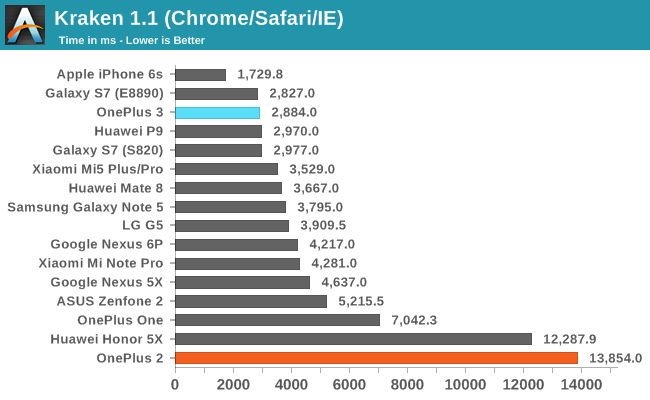
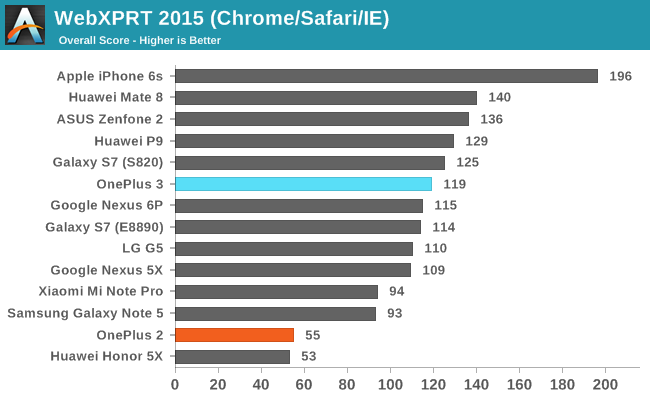
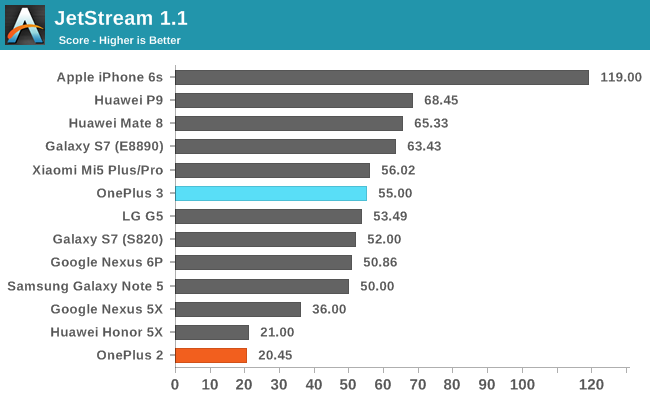
The improvement in web browsing performance when going from the OnePlus 2 to the OnePlus 3 is staggering. This isn't unexpected when you consider that the OnePlus 2 was just running on Cortex A53 cores that were meant for low power scenarios while the OnePlus 3 is using Qualcomm's Kryo cores. In Kraken the OnePlus 3 is over four times faster, while in WebXPRT and JetStream it's at least over two times faster. The OnePlus 2 actually represented a large regression in web performance compared to its predecessor, and OnePlus has brought web performance back to a level that is competitive with the other smartphones on the market with the OnePlus 3.

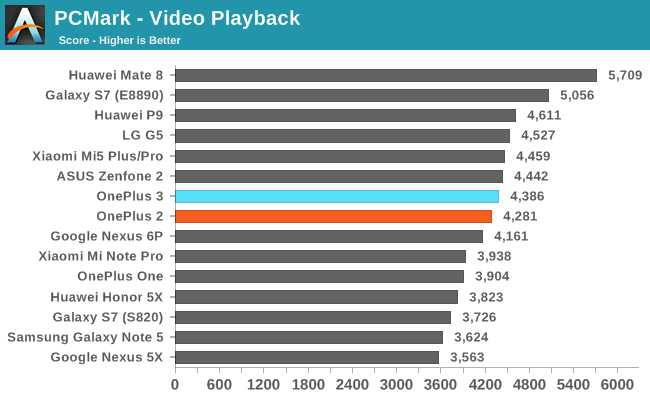

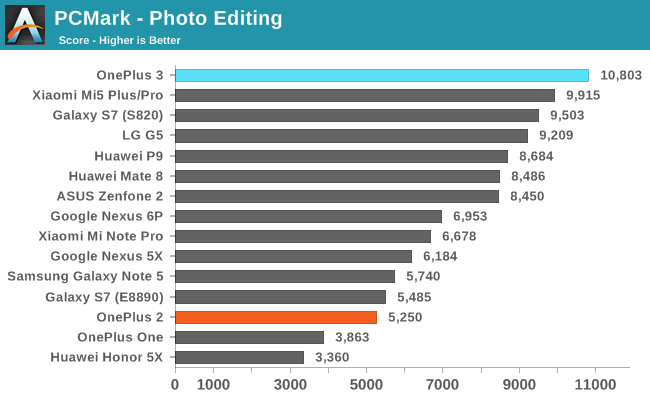
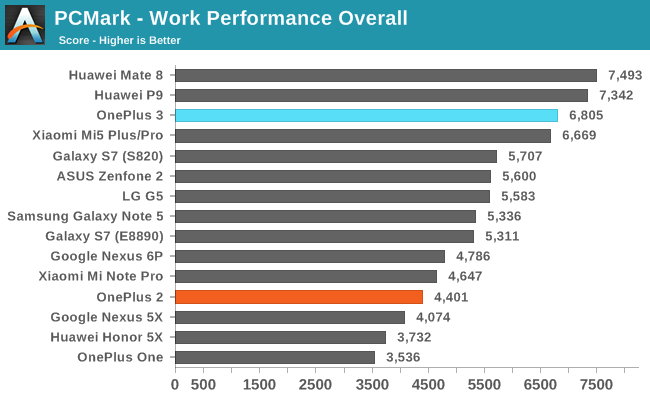
PCMark is an interesting test because it depends just as much on a phone's software as it does on the hardware. We've seen how devices with the same SoC can perform very differently, especially in certain sub-tests like the Writing and Photo Editing tests where different runtime and OS optimizations can have a large impact. The OnePlus 3 is no exception, with it achieving higher scores than the LG G5 in every test except for video playback where they have roughly the same scores.
This is not unexpected, as it was demonstrated in the LG G5 review that the G5 has more conservative frequency scaling than the other Snapdragon 820 devices that we've seen, which is reflected in PCMark's tests. In any case, the OnePlus 3 actually gets close to the Huawei Mate 8 in the writing test, and beats it and the LG G5 by a large margin in the photo editing test. In the end the OnePlus 3 places second on our overall chart, with only the Huawei Mate 8 ahead of it, and the gap between it and the Mate 8 being smaller than the gap between it and the Zenfone 2 which is the next fastest smartphone.
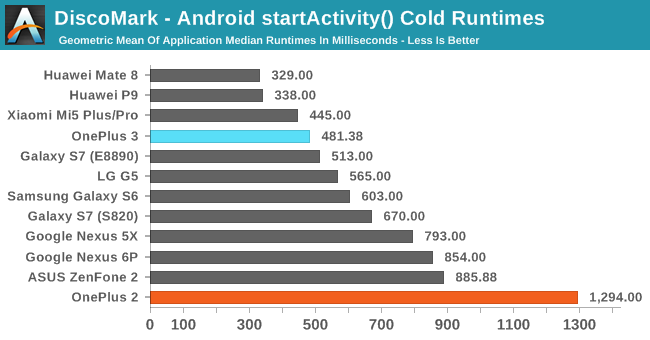
The OnePlus 3 is over two times faster than the OnePlus 2 with cold app launches where the application isn't resident in memory in any state. This is likely a combination of improved NAND performance, and changes to OnePlus's DVFS settings in addition to the performance improvements that Snapdragon 820 provides on its own. The impact that this has on the performance of the interface is significant, and when I reviewed the OnePlus 2 I noted how painfully slow it was to move around and through the applications. This new testing is a great example of that, with the OnePlus 2 taking 1.3 seconds just to launch apps, while the OnePlus 3 takes under 500ms and is the second fastest device here.
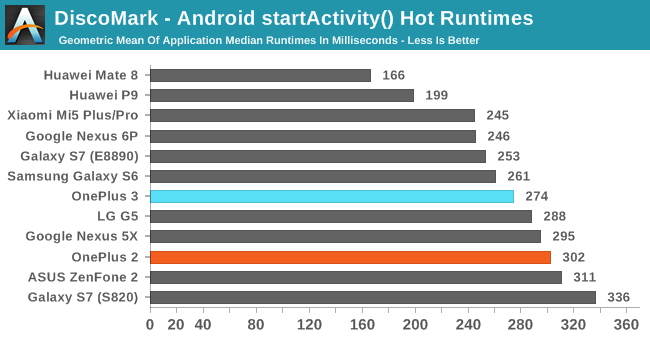
The OnePlus 3 improves a bit over the OnePlus 2 when resuming apps that are resident in memory, but not by a great deal. In general, all our devices hover between 250 and 300ms here, with the exception of the Huawei Mate 8 and P9 which are really in a category of their own for performance. While there's no enormous improvement here, the OnePlus 3 is competitive with other high end devices in the market, so there's nothing to complain about either.
One thing worth noting is that our set of apps wouldn't come close to utilizing the OnePlus 3's 6GB of RAM. Unfortunately, no matter how many apps we added, this would actually still be the case. The reason is that OnePlus has implemented very aggressive app eviction from memory, which means that your 6GB of RAM is really just sitting there using energy, and in general the utilization is pretty low. This may be a holdover from when the OnePlus 2 shipped in a 3GB configuration, but it's something OnePlus needs to address in a future OTA update. I'd imagine the Android enthusiast community is already at work on, or has already created custom kernels to alter this behavior as well. With 6GB of RAM you should be able to comfortably keep all of a user's frequently used apps resident in memory.
It's great to see that OnePlus is producing a smartphone with competitive performance once again. When the OnePlus One launched, Snapdragon 801 was the best you could get in an Android smartphone. The OnePlus 2 was an unfortunate victim of Snapdragon 810's heat and throttling problems, but OnePlus certainly didn't help the issue by hardcoding in mechanisms to detect Google Chrome and shut the A57 cluster off entirely. With the OnePlus 3 you get some of the best CPU performance in an Android phone, with PCMark's real-world tests demonstrating noticeable gains over the LG G5 which also uses Snapdragon 820. If I had to sum things up in a single line I'd just say that it's good to see that OnePlus is back in the game.


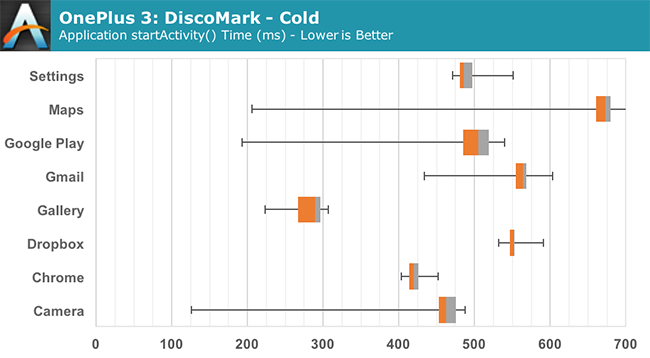
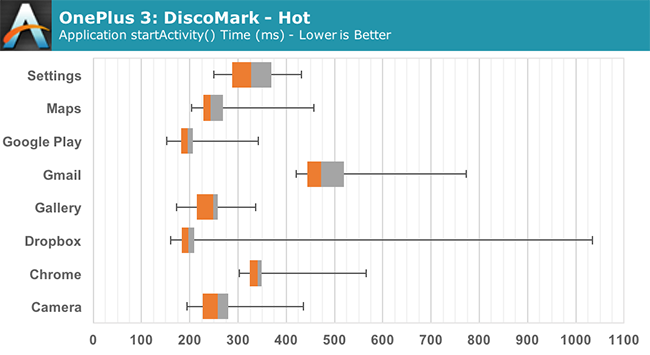








176 Comments
View All Comments
pcpoweruser - Monday, June 20, 2016 - link
You are simply not getting something - display accuracy has very little to do with sRGB color space itself. sRGB is a relatively dull, limited colorspace that defines collors far bellow what human eyes can see and it only exists because wider gamut was problematic to achieve on pre-OLED displays. AdobeRGB (that OLEDs can reach) is far richer, vibrant closer to life color space.Personally, I would never use modern, wide-gamut OLED display in crippled sRGB mode that essentially limit panel ability do render deep, saturated colours, it is just not 'fun'. Many of these colors are just UI elements, icons, etc - they look much nicer with wide gamut. Yes, I cannot believe that Android still does not have any form of color management built in and think it is a total disgrace. As a result, the cost of using full abilities of wide gamut displays is that photos (typically designed to be shown on sRGB display) will look oversaturated, even if they are embedded with proper sRGB/AdobeRGB profile, as Android simply have no way to process it. However, to be fair, I a can live with this - I am not a photographer and do not need accurate saturation in photos on my mobile.
But to the point: AdobeRGB (that many OLEDs target) is essentially extension of sRGB, so on OS that does not understand color management, photos with sRGB profile would simply look more saturated - but the colors would be still accurate (i.e certain share of red would be still the same shade, just more intense). NTSC that Oneplus 3 panel seems to target is a different gamut, that is 'shifted' in space (look at CIE graphs), so for instance orange might become red - and this is a problem.
Additionally, there is another aspect of accuracy: balance of individual primary colours at various intensity steps (so called 'greyscale') - and this is quite broken in Oneplus 3 too (yes, I have got one) - blue is dominating heavily pretty much all the intensity steps.
Combined with a very high color temperature ('balance' option in the UI does not help much, it just adds hideous pink hue) and low ~800p real resolution thanks to pentile pattern (with all the artifacts like diamond-shaped fill and color fringing at hight contrast edged) the result is simple - the display is objectively very bad.
My point of reference is to N6P panel, which is absolutely gorgeous, accurate and ultra sharp in comparison.
It is a shame, as otherwise phone is great (build quality, SoC, fast storage), but looking at the screen is just too painful for me - so I am sending it back.
I understand that possibly less than 1% really care about quality of the display, but I am one of those people and totally agree with the reviewer here.
grayson_carr - Tuesday, June 21, 2016 - link
You've missed my point entirely, which was to request that Anandtech provide measurements for displays as they are calibrated out of the box. By default, the Galaxy S7 and Nexus 6P are just as bad, calibration wise, as the OnePlus 3. They are not calibrated to any standard. Not sRGB, not Adobe RGB. Yes there are sRGB modes on both the S7 and 6P, which are what Anandtech tests and publishes results for, and there is also an Adobe RGB mode for the S7, but when you take those phones out of the box, the calibration of each is truly awful, just like the OnePlus 3. Uhg, and you're acting like the 6P has some great panel. God, the 6P screen is sharp and accurately calibrated (in sRGB mode), sure, but it has a horrible grainy look to it and has awful sunlight visibility in sRGB mode (sunlight visibility in the default inaccurate mode is fine, but it's truly terrible in sRGB mode). I own an S7 Edge, OnePlus 3, and Nexus 6P because I'm an Android app developer, so I can compare them all side by side here.pcpoweruser - Tuesday, June 21, 2016 - link
You are missing my point too: 6P in default mode is fine - it targets colour space similar to AdobeRGB, so colors are just more saturated, but they are still the same colors. There is no reason to use sRGB mode on 6P (as you mentioned it impacts maximum brightness badly - like any color curve adjustment) unless you are a photographer and work with sRGB photos on your workstation - by using sRGB mode you are simply crippling display capability to show wide gamut.Oneplus 3 is different, by default it targets odd gamut that actually shitfs colors and make them very different colors - this does not happen 6P. Not to mention terrible white balance and greyscale, which is just fine on 6P in non-sRGB mode. Grainy look on 6P display: is this a joke? Maybe with some dodgy screen protector. It is one of the sharpest, cleanest displays and makes Oneplus 3 look absolutely terrible in comparison.
grayson_carr - Wednesday, June 22, 2016 - link
"colors are just more saturated, but they are still the same colors"What? Not to me. If you take a color and make it way more saturated, it is not the same color. I guess you're saying green will still be green, etc, but just more saturated. I get that. But it still makes photos look untrue to life if the colors are all oversaturated. And even if I accept your explanation for the 6P, what about the S7 and Note 5? The default adaptive mode on those phones is NOT sRGB nor Adobe RGB. It's Samsung's made up colors that they think look good and it's no better than what we see on the OnePlus 3. If Anandtech would test these modes we would see that, which is why I want Anandtech to start testing and discussing them.
Buk Lau - Monday, June 20, 2016 - link
maybe because other so called "reviews" don't even have a colorimeter to properly test displays? subjectively saying "oh it looks good to me" doesn't mean much to everyonegrayson_carr - Monday, June 20, 2016 - link
The display is only 'bad' from a color accuracy standpoint. I actually have the phone, and also own a Galaxy S7 Edge and Nexus 5X. Subjectively, if you hand a random person on the street all three of these phones, they would probably say the OnePlus 3 display looks the best. The Nexus 5X is technically the most accurate, but looks washed out next to the other two to your average person who doesn't deal with color accurate displays for a living. The S7 Edge (mine anyways) has whites that lean too much towards green, so it looks kind of unnatural. I thought the lower resolution of OnePlus 3 would bother me because the display is pentile, but honestly, the screen density it set such that I never bring the phone close enough to my face to notice. Also, while I don't have a measurement device, I think the white balance of my OnePlus 3 is not as cool as the one Anandtech received. Comparing it to other phones, I would guess my sample is more in the 7500K range. Brandon also seems to have missed the color temperature slider in the display settings. I wonder if he had adjust the color temperature a bit warmer if the color measurements would have been a little better.grayson_carr - Monday, June 20, 2016 - link
Oh, I forgot to mention, if you like how the Galaxy S6, S7 and Note 5 displays look in their default adaptive display mode, you will probably like how the OnePlus 3 display looks because it looks very similar to that. Unfortunately, Anandtech and everyone else only test the color accuracy of Samsung displays after changing the display mode to basic / sRGB, which almost no one uses in reality. So you will hear the Galaxy S7 display is suuuupppppeeeerrrr accurate, blah, blah, blah!!! But if you go out and survey actual Galaxy S7 owners on the street, 99.9% of them will be using the default display setting that is not accurate at all and probably no more accurate than the OnePlus 3 display, yet people still say it looks great. So bottom line, don't write of the OnePlus 3 because Anandtech hates the display.Buk Lau - Tuesday, June 21, 2016 - link
it's ok, we get it, you are trying to defend your purchase. Idk if you have read any of those reviews you mentioned so far (probably not as you are still saying these), but in N6P review they clearly gave out results for both profiles. also what you are forgetting is that this is not simply a color profile issue, 1+ just straight up didn't calibrate these panels out of the box. what people like is different from what something objectively is. you can like the 1+3 and its poorly calibrated panels, but that doesn't change the fact that the panel is inaccurate. there's a reason why these standards exist, and just because you don't like the standard doesn't mean it's important.grayson_carr - Wednesday, June 22, 2016 - link
Why would I need to defend my purchase? I own a Galaxy S7 edge and will be keeping it as my main phone and returning the OnePlus 3. I only bought a OnePlus 3 because I am an Android app developer and phone enthusiast and just like trying all of the new phones. That's great that they gave out results of both profiles for the 6P, but if I remember correctly, it's only because they tested the default profile before they discovered the sRGB mode. They never test the default profile of Samsung phones. I want them to call Samsung out for shipping phones with displays that are so inaccurate out of the box. Yeah, it's great that Samsung gives you an accurate profile setting, but when you just test that and don't even mention the default profile, it confuses people and makes most people think Samsung displays are accurate right out of the box. Even many reviewers at other popular sites obviously don't know that Samsung displays are onky accurate in basic mode.grayson_carr - Wednesday, June 22, 2016 - link
there's a reason why these standards exist, and just because you don't like the standard doesn't mean it's important.Wtf dude? You've got me all wrong. I'm a proponent of sRGB. I like it and wish all phones were calibrated to that standard out of the box. That said, if you're going to completely trash a phone for not being calibrated to sRGB out of the box, you need to trash every phone that isn't calibrated to that out of the box to some extent, but Samsung just throws in an sRGB profile that no real world users even know about and gets away with shipping displays that aren't calibrated to any standard at all by default (cough... adaptive mode)???